The grit and velocity of small town Ohio shine through again in the rankings of the year’s top micropolitan regions. Economic development, like any game-changing enterprise, is hard work. Communities that excel at it do so through persistent attention to business retention and recruitment, tax and regulatory strategies, technical assistance and workforce development. In 2016, the efforts and rewards of Ohio micropolitans were not just impressive, they outpaced the rest of the nation by a strikingly wide margin.
rather than one big boom.”
Led by Findlay, which racked up 22 qualifying investments, more than any micropolitan for the third consecutive year, Ohio blew away all comers in 2016 with 105 major business investments and expansions in micropolitan areas, more than twice the number achieved by second-place North Carolina, which claimed 46 such deals, tracked by Site Selection’s proprietary Conway Projects Database.
Among the nearly 500 corporate facility projects scattered among the nation’s Top 100 micropolitan areas, certain patterns emerge. First, there is a strong correlation with Interstate highways, with the jurisdiction often well placed and equidistant between larger markets. There is also a pronounced lean toward incremental growth by satisfied customers: 65 percent of the projects were expansions, vs. new greenfield sites. As for industry sector, the trend persists from the world’s leading sectors in terms of project activity (see p. 132) — transportation equipment, plastics/chemicals, and everyone’s favorite industrial niche: food and beverage.
Last but not least, the nation’s leading small towns are peppered with international flavor, as companies from Japan to Korea to Thailand to Germany to Israel find homes in areas many Americans would agree are not just business-friendly, but friendly in general.
Findlay: Crown Jewel of Micropolitans
Luring away a business from another city or town makes great headlines. But the strongest returns for local economies come from retaining existing operations and helping them grow. It’s one of the recipes that continues to work for high-performing Findlay, which has placed among Site Selection’s top 10 micropolitans a remarkable 11 times since 2000.
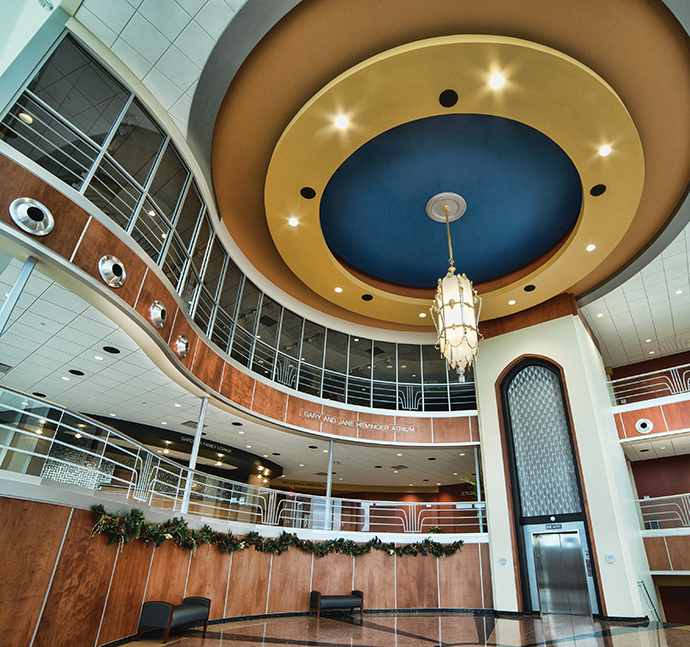
All of Findlay’s qualifying projects in 2016, totaling $127 million, came in the form of expansions by firms already operating there, including the city’s two economic anchors, Marathon Petroleum and Cooper Tire. Both companies make their headquarters in Findlay, and the town’s economy has grown alongside them. Marathon, which has been in Findlay for roughly 100 years, recently pumped $90 million into a new main campus, while Cooper’s 2016 capital investments in Findlay totaled $11 million.
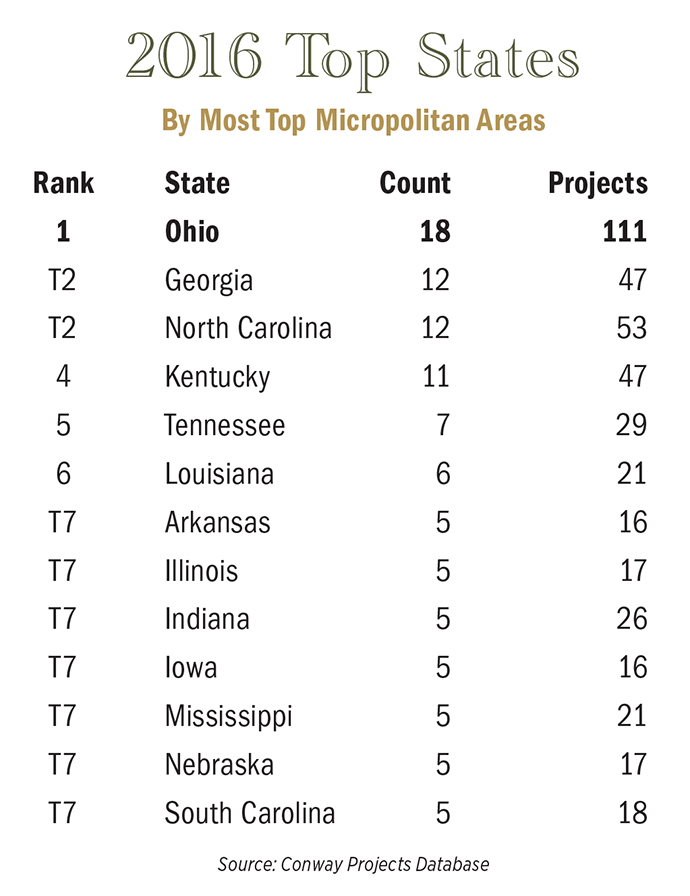
For Tim Mayle, director of Economic Development for the privately funded Findlay-Hancock County Alliance, this is where attracting, retaining and nurturing a diverse roster of businesses becomes a self-fulfilling prophecy for growth.
“We like to see smart growth rather than one big boom,” says Mayle, noting that Findlay witnessed the creation of 1,070 jobs in 2016. “If you go back 25 years to Nissin Brake, when they first came to Findlay they employed less than 100 people, and they now employ 1,200. We look for companies that have a history of success that fit within our sectors that we know we’re strong in, companies we think have an opportunity to grow over time at the kind of rate that our community can handle.”
In its quarter-century in Findlay, Nissin Brake Ohio has become one of the strongest performers in Findlay’s deep lineup of suppliers to the automotive industry. A division of Japan’s Nissin Kogyo Co. Ltd., Nissin supplies brake systems to Honda and Harley-Davidson.
Will Schroeder, Nissin plant manager, says the company’s partnership with the town and people of Findlay has produced a range of benefits.
“The Findlay community has been very welcoming to our Japanese expats,” says Schroeder. “There’s a great quality of workforce here. With the economy being so vibrant, the quantity of workers is becoming a little more scarce, but what we have is a semi-rural community and a workforce that’s dedicated and hardworking.
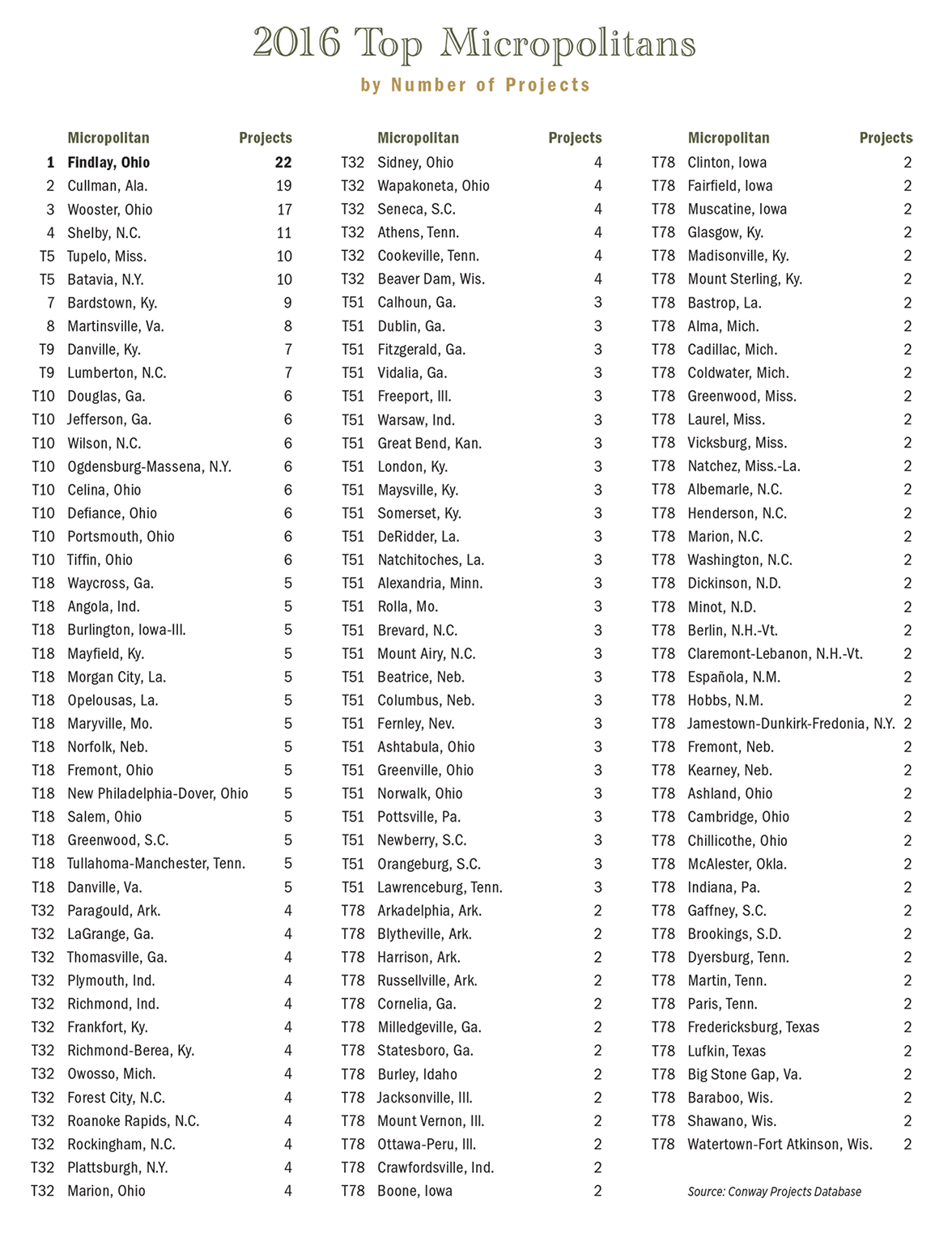
“There’s a lot of competition for workers,” Schroeder explains. “But there’s a variety of innovative programs that the local community has started. There are a number of items they’re helping industry with, including education.”
Recently, Nissin entered a joint venture with automotive safety giant Autoliv of Sweden. The Nissin-Autoliv partnership — with manufacturing operations in Japan, China, and Findlay — was formed to develop sensor-triggered, autonomous braking systems.
“There’s a portion of Nissin’s business that’s been carved out,” says Schroeder, “and it’s a good fit for Autoliv. Autoliv is the leading supplier of safety systems for the entire automobile market. But one of the pillars Autoliv didn’t have was brake systems for integrated, autonomous driving. That was one of their missing pieces, and now with the joint venture that’s coming to fruition.”
Findlay’s Tim Mayle sees enormous potential in the Nissin-Autoliv partnership. Peering into the future, he sees an opening into the looming bonanza of driverless cars. While Nissin supplies Honda, Autoliv sells to the Big Three; Findlay, on I-75 in northwest Ohio, is poised in the middle of it all.
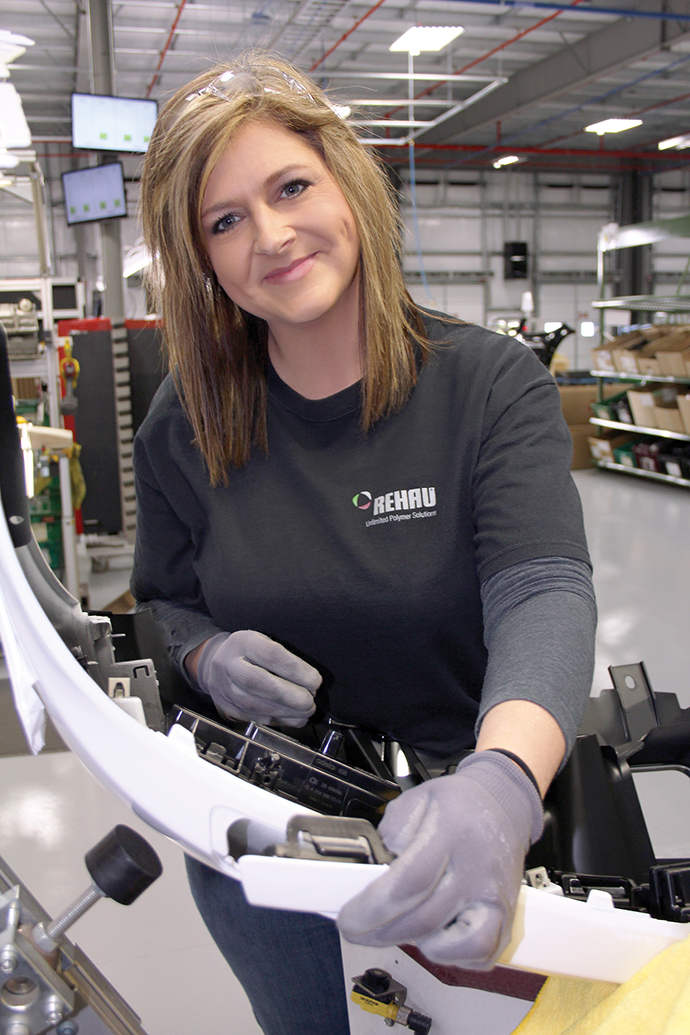
“We’re excited,” says Mayle. “We think there’s a real opportunity here over the next four to five years to look at advanced manufacturing tied to the automotive market.”
As if to underscore Findlay’s accomplishments, the city’s downtown district is getting a facelift. Soon, 10 blocks of Main Street will meet the jackhammers for a streetscaping and bike path project. Marathon recently built Findlay an $18-million performing arts center, and local leaders have hopes for a high-end downtown residential development within walking distance of it. Then, says Mayle “we’re going to have a Main Street that will show as well as any Main Street anywhere.”
Mayle, to no one’s surprise, views urban beautification and culture through an economic lens. He sees “catalytic development” spreading out from Findlay’s center and attracting more talent to help meet the business community’s insatiable demand for workers, “from factory to cardiovascular,” he says. It all gets back to doing the hard work.
“Due to our size,” says Mayle, “we have to be very proactive in Findlay.”
Whirlpool Goes Big in Micropolitan Ohio
A deeper plunge into the numbers puts Ohio’s accomplishment in starker relief. Including ties, the Buckeye State placed two micropolitans in the nation’s top five, six micropolitans among the top 10, and eight in the top 20. Ohio’s top 20 micropolitans of 2016 include Findlay, Wooster, Celina, Defiance, Portsmouth, Tiffin, Fremont and Salem. In those eight areas alone, major business investments totaled close to $1 billion with 3,470 jobs created.
Investments by appliance manufacturer Whirlpool exemplify the successes of small town Ohio for 2016. Whirlpool is a global enterprise that’s found a prosperous home among a scattering of Ohio micropolitans. Last year, Whirlpool spread investments across four Ohio micros, where the company employs some 10,000 workers. The company’s new investments include a $40.6-million expansion of its dishwasher plant in Findlay, which makes 12,500 units per day, more than any other dishwasher facility in the world. The Findlay plant, which makes dishwashers under the Whirlpool, Maytag, Jenn-Air, KitchenAid and Amana labels, celebrates its 50th anniversary in 2017.
Since 2010, Whirlpool has invested more than $1 billion in the US in new facilities and upgrades, including the newly completed $40-million expansion of its KitchenAid plant in the Ohio micropolitan of Greenville, where the company makes the popular KitchenAid stand mixer. The 218,000-sq.-ft. (20,253-sq.-m.) Greenville expansion nearly doubled the size of the plant, and is expected to lead to the creation of 400 new jobs by year’s end. In addition, Whirlpool committed $17 million to the expansion of its Greenville distribution facility. That expansion will put all of the site’s global distribution beneath one roof.
Other Whirlpool investments in Ohio included a $32-million infusion into the company’s laundry facilities in the Fremont micropolitan area, and $14 million to erect three wind turbines to help power its clothes-dryer plant in Marion. The wind project is expected to eliminate the equivalent of more than 9,000 tons of carbon dioxide at the Marion plant, where Whirlpool employs 2,400 workers, making it the largest employer in surrounding Marion County.
“The wind turbines are not only a responsible investment for the environment,” said James Gifford, Whirlpool’s Marion facility plant lead, “but also a smart financial decision. By reducing our electricity consumption, we expect to cut down on our overhead costs significantly.”
“We’re always exploring cutting edge technologies that will bring us closer to accomplishing our sustainability goals,” said Ron Voglewede, Whirlpool’s director of sustainability. “We’re excited to bring a local focus for our global commitment to sustainability here in the Marion community and throughout Ohio, where we have significant investments in employees and facilities.”
Nice Grouping
Ohio’s bevy of Top Micros certainly gets top billing. But there are other states that can also boast their own Top Micro clusters.
North Carolina claims No. 4-ranked Shelby, No. 9 Lumberton and No. 10 Wilson, which tied with seven other areas for 10th place. Two of those ties — Douglas and Jefferson — were in Georgia, which also is home to Waycross, one of several tied for 18th place. Jefferson, positioned northeast of Atlanta along I-85, is a distribution capital, welcoming big new warehouse investments from Williams-Sonoma, FedEx Ground and Amazon.
No. 7 Bardstown, Kentucky, finds Kentucky Top Micro sister cities in Danville (tied for 9th) and Mayfield, among those tied at 18th in the nation. The biggest project in Bardstown these days is a $110-million investment from automotive metal stamping and die manufacturer Thai Summit Group, a 40-year-old Thai firm whose first plant was in Howell, Michigan. Danville’s project menu is a typical sampling of micropolitan industry sectors: In addition to investments from diesel generator manufacturer Denyo, conveyor maker Intelligrated and auto parts stamping firm Lincoln Manufacturing, the area has also welcomed an investment from Wilderness Trail Distillery. It’s also home to new cherry tomato and green pepper greenhouse operations from Kentucky Fresh Harvest, launched by third-generation Israeli farmer Haim Oz, whose Oz Agribusiness Projects & Investments has successfully developed high-tech greenhouse and other agriculture projects on five continents.
The big news in Mayfield is the move by West Kentucky and Tennessee Telecommunications Cooperative (WK&T) to turn the former Mid-Continent University into a technology park for startups and workforce training, thanks to a tax-increment financing arrangement that will inject $40 million into the property.
Ryan Drane, president of Graves County Economic Development, says WK&T will move its HQ there from elsewhere in town. But the telecom co-op is an anchor in more ways than that: With the help of $125 million in economic stimulus money, it ran 2,000 miles of gigabit fiber underground to businesses and residences.
Drane says the county of 38,000 has benefited from a number of smaller expansions, such as a $2-million, 40-job project from metal fabricator K-Fab.
“We’re on the new I-69 corridor, and starting to see some movement from that,” he says, including new retail development. “It’s been so long since the feds have built a border-to-border Interstate. Everybody is just trying to find their place and take advantage of that.”
Another of the 10th-place ties was in Ogdensburg-Massena, New York, a state that also claims No. 5 Batavia (tied with Tupelo, Mississippi). Part of the Ogdensburg-Massena micropolitan area is Potsdam, where robotic farm company Agbotic has made a $13-million investment that, despite the seeming irony, is creating 21 jobs.
The company was launched in 2014 by SUNY-Potsdam graduate John Gaus, and received a $2-million grant in 2015 as part of the state government’s regular rounds of economic development grant competition.
Shelby’s roster of recent projects includes a major $75-million investment in Kings Mountain from T5 Data Centers, which counts Boeing among its end-user customers; a $15-million, 113-job investment from composite materials firm Mafic; a $36-million, 150-job project from Uniquetex, a $12-million, 22-job project from STI Fabrics and an $80-million, 80-job investment from KSM Castings Group.
Outliers can be just as significant as clusters: No. 2 Cullman, Alabama, is a perennial top performer, perched alongside I-85 just west of the Georgia state line, and the only Alabama town among the Top Micropolitans ranked this year.
The mix of products out of Cullman includes a bunch of automotive parts moving both ways on that highway. One company encapsulates Cullman’s success: REHAU. Since opening its initial facility in Cullman in 1995, the company has expanded four times across multiple automotive and other product lines.
The most recent announcement came in August 2016: a five-year, $5-million, 50-job expansion sparked by new business producing gaskets for a major appliance manufacturer. The site currently employs 1,000 in Cullman, a town whose entire CBSA consists of just under 19,000.
The Best Micropolitans Are Nimble
The White House Office of Management and Budget defines a micropolitan statistical area as one or more adjacent counties that have at least one urban core area of at least 10,000 population but less than 50,000, plus adjacent territory that has a high degree of social and economic integration with the core as measured by commuting ties. As of 2015, the nation has 575 regions that qualify as micropolitans.
Micropolitan regions do not carry the same economic weight as large cities do, but they are nonetheless significant centers of population and production. By area, some micropolitans are actually larger than regions classified as metropolitans.
William Fruth, founder and owner of POLICOM, an independent research firm based in Palm City, Florida, tracks 28 different measurements to gauge the relative and long-term health of every metro and micropolitan area in the United States.
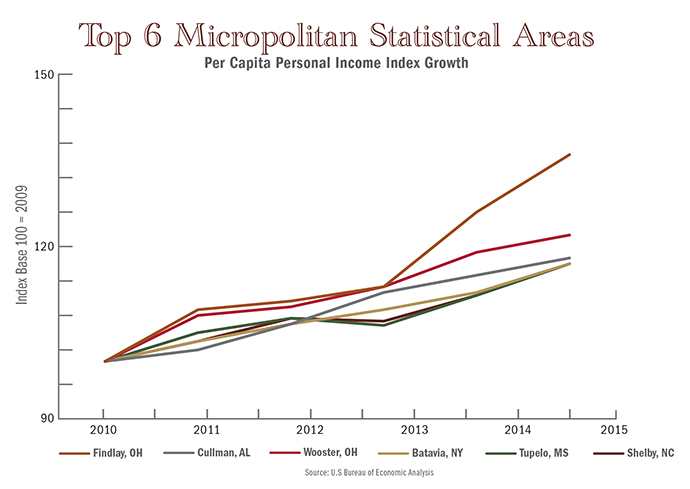
“Since they’re smaller, the economic principles of micropolitan economies are easier to measure,” says Fruth. “Take Columbus, Mississippi. They’re an economy that was solely dependent on the Columbus Air Force Base in the ‘90s and they feared closure. So they embarked on an economic development and diversification program as a community, and they’ve had tremendous success in attracting advanced manufacturing. They’re continuously improving.
“The advantage to a smaller economy,” Fruth continues, “is they are politically more nimble. It’s much harder for a large government to react to a problem than it is for a small government. A micropolitan government can immediately address the needs of its companies in a better fashion than a larger government.”
Among the factors most crucial to the success of a micropolitan economy, Fruth lists these:
- Community commitment to growth
- Abundant supply of permitted land
- Diversified economy
- Multiple transportation systems, including regional airports
- Geographic location
- Low cost of doing business
- Abundant workforce
- Incentives
“It’s also a characteristic of the strongest micropolitan economies,” says Fruth, “to have active, well-financed, professionally operated economic development organizations. One of the reasons is that organization can see what needs to be done to build the economy. They can tell the community, ‘We have to connect to the Interstate. We have to have a more sophisticated worker training program.’ An economic development organization has to be there to do that.
“If the community doesn’t want growth to happen,” says Fruth, “it won’t happen.”

